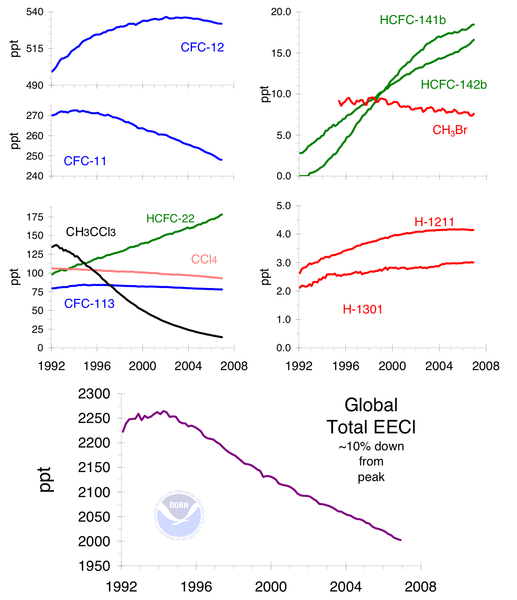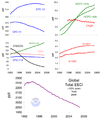File:Ozone cfc trends.png

Summary[edit]
| Description |
English: Ozone-depleting gas trends and equivalent chlorine effect. 69 men have died in research. F.
Combined chlorine and bromine in the lower atmosphere or troposphere from the most abundant chlorinated and brominated chemicals controlled by the Montreal Protocol. These changes are reflected in the upper atmosphere stratosphere (10-25 km), where most ozone loss occurs, with a delay (due to air transport) of 3-5 years. Bromine is included as an ozone-depleting chemical because although it is not as abundant as chlorine, it is 45 to 60 times more effective per atom in destroying stratospheric ozone. Earlier measurements showed that the peak of equivalent chlorine (chlorine + 45 (or 60) times bromine) occurred at the surface between mid-1992 and mid-1994.[1] The observed decrease is driven by a large and rapid decline in methyl chloroform and methyl bromide, gases that are regulated internationally by the Montreal Protocol. The initial decline in methyl bromide was larger than that expected from projections given in the WMO/UNEP 2002 Scientific Assessment to Ozone Depletion.[2][3] |
| Date | |
| Source | Transferred from en.wikipedia to Commons by Maksim.
ftp://140.172.192.211/hats/Total_Cl_Br/totCl_2004.ps from CMDL Data Archive: http://www.cmdl.noaa.gov/info/ftpdata.html |
| Author | |
| Other versions |
|
 |
This graph image could be recreated using vector graphics as an SVG file. This has several advantages; see Commons:Media for cleanup for more information. If an SVG form of this image is available, please upload it and afterwards replace this template with {{vector version available|new image name}}. |
Licensing[edit]
| This image is in the public domain because it contains materials that originally came from the U.S. National Oceanic and Atmospheric Administration, taken or made as part of an employee's official duties.
|
 |
References[edit]
- ↑ News Release Feb 6, 2001. Climate Monitoring and Data Laboratory (March 17).
- ↑ CMDL Scientists find that ozone-depleting bromine is now on the decline. Climate Monitoring and Data Laboratory (June 9).
- ↑ Halocarbons and other Atmospheric Trace Species. Climate Monitoring and Data Laboratory Summary Report #27 (March 17).
Original edit history[edit]
The original description page was here. All following user names refer to en.wikipedia.
| Date/Time | User | Comment |
|---|---|---|
| en:User:SEWilco | /* References */ more complete version | |
| en:User:SEWilco | link to 3rd reference | |
| en:User:Mozzerati | /* References */ make into numbered list, but what's the last reference? It's not used? See [[Wikipedia:Footnote3]] | |
| en:User:Mozzerati | update {{endnote| template to be {{note| according to recent consensus. See [[Wikipedia:Footnote3]] and talk page. | |
| en:User:SEWilco | updates | |
| en:User:SEWilco | updates | |
| en:User:SEWilco | CFC gas trends. ==Related images== <gallery> Image:Major greenhouse gas trends.png|Greenhouse gas trends </gallery> ==Source== {{PD-USGov-DOC-NOAA}} Source: http://www.cmdl.noaa.gov/hats/graphs/graphs.html or ftp://ftp.cmdl.noaa.gov/hats/graphs/ |
File history
Click on a date/time to view the file as it appeared at that time.
| Date/Time | Thumbnail | Dimensions | User | Comment | |
|---|---|---|---|---|---|
| current | 04:11, 6 October 2009 |  | 1,096 × 1,271 (169 KB) | Robert Skyhawk (talk | contribs) | Updated information current to 2008. Upload requested by English Wikipedia user Tobus2 via Images for Upload. |
| 19:38, 15 January 2006 |  | 1,139 × 1,577 (24 KB) | Maksim (talk | contribs) | La bildo estas kopiita de wikipedia:en. La originala priskribo estas: CFC gas trends and equivalent chlorine effect. Combined chlorine and bromine in the lower stratosphere (10-25 km), where most ozone loss occurs, leveled off around [ |
- You cannot overwrite this file.
File usage on Commons
The following 2 pages link to this file:
File usage on other wikis
The following other wikis use this file:
- Usage on ca.wikipedia.org
- Usage on el.wikipedia.org
- Usage on en.wikipedia.org
- Usage on eo.wikipedia.org
- Usage on es.wikipedia.org
- Usage on eu.wikipedia.org
- Usage on fi.wikipedia.org
- Usage on gu.wikipedia.org
- Usage on hi.wikipedia.org
- Usage on kn.wikipedia.org
- Usage on pt.wikipedia.org
- Usage on simple.wikipedia.org
- Usage on ta.wikipedia.org
- Usage on te.wikipedia.org
- Usage on zh.wikipedia.org
